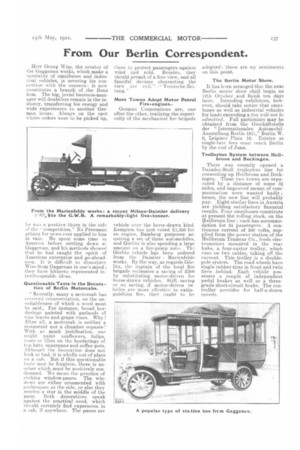From Our Berlin Correspondent.
Page 7

If you've noticed an error in this article please click here to report it so we can fix it.
Herr Georg Wiss, the creator of the Gaggenau works, which make a speciality of omnibuses and industrial vehicles, is severing his connection with the concern : it now constitutes a branch of the Benz firm. The big, jovial business-manager will doubtless remain in the industry, transferring his energy and wide experiences to another German house. Always on the spot where orders were to be picked up, he was a positive thorn in the side of the " competition." No Pressman athirst for news ever applied to him in vain. He spent some time in America before settling down at Gaggenati, and his methods showed that he had caught the spirit or American enterprise and go-aheadness. It is difficult to dissociate Wiss from Gaggenau in one's mind ; they have hitherto represented interchangeable ideas.
Questionable Taste in the Decoration of Berlin Motorcabs.
"Recently, many a motorcab has received ornamentation, on the unsuitableness of which a word must be said., For instance, broad bordering.; painted with garlands of vine leaves and grape vines. Why After all, a motorcab is neither a restaurant nor a chambre separee ! With as much justification, one might paint. sunflowers, tulips. roses or lilies on the borderings of top hats, saucepans and coffee-pots. Although the decoration does not look so bad, it is wholly out of place on a cab. But if this questionable taste may be forgiven, there is another which must he positively condemned. We mean the practice of etching window-panes. The windows are either ornamented with arabesques at the side, or else they receive a star in the middle of the pane. Both decorations speak against the practical need, which should certainly find expression in a cab, if anywhere. The panes are
there to protect passengers against wind and cold. Besides, they should permit of a free view, and all fanciful devices obstructing the view are evil."—" Vossisehe-Zeitung."
More Towns Adopt Motor Petrol Fire-engines.'
German Corporations are, one after the other, realizing the superiority of the mechanical fire-brigade
vehicle over the horse-drawn kind. Kempten has just voted 7E1,350 for an engine, Bamberg purposes acquiring a set of three automobiles, and Gorlitz is also spending a large amount on a fire-pump auto. ThGOrlitz vehicle has been ordered from the Daimler Marienfelde works. By the way, as regards Gorlitz, the captain of the local fire brigade estimates a saving of 2300 by substituting motor-driven for horse-drawn vehicles. Still, saving or no saving, if motor-driven vehicles are more effective in extinguishing fire, they ought to be
adopted : those are my sentiments on this point.
The Berlin Motor Show.
It has been arranged that the next Berlin motor show shall begin on 12th October and finish ten days later. Intending exhibitors, however, should take notice that omnibuses as well as industrial vehicles for loads exceeding a ton will not be admitted. Full particulars may be obtained from the Geschaftstelle der " Internationalen AutomobilAusstellung Berlin 1911," Berlin W. 9, Leipizer Plats 16. Entries at single-rate fees must reach Berlin by the end of June.
Trolleybus System between Heilbronn and Bockingen.
There was recently opened a Daimler-Stoll trolleybus line for connecting up Heilbronn and Bockingen. These two towns are separated by a distance of some 3i miles, and improved means of communication were wanted badly ; hence, the new line will probably pay. .Eight similar lines in Austria are yielding satisfactory financial results. Four omnibuses. constitute at present the rolling stock, on the Heilbronn line ; each has accommodation for 24 passengers. A continuous current of 500 volts, supplied from the power station of the Heilbronn Tramcar Co., feeds electromotors mounted in the rear hubs, a four-castor trolley, which runs on two cables, taking off the current. This trolley is a doublepole system. The road wheels have single rubber tires in front and twin tires behind. Each vehicle possesses a couple of independent pedal brakes as well as a threegrade short-circuit brake. The controller provides for half-a-dozen speeds.






















